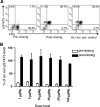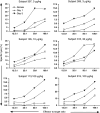IL-21 induces in vivo immune activation of NK cells and CD8(+) T cells in patients with metastatic melanoma and renal cell carcinoma
- PMID: 18286285
- PMCID: PMC2491425
- DOI: 10.1007/s00262-008-0479-4
IL-21 induces in vivo immune activation of NK cells and CD8(+) T cells in patients with metastatic melanoma and renal cell carcinoma
Abstract
Purpose: Human interleukin-21 (IL-21) is a class I cytokine previously reported in clinical studies on immune responsive cancers. Here we report the effects of systemic IL-21 therapy on the immune system in two phase 1 trials with this novel cytokine.
Experimental design: Recombinant IL-21 was administered by intravenous bolus injection at dose levels from 1 to 100 microg/kg using two planned treatment regimens: thrice weekly for 6 weeks (3/week); or once daily for five consecutive days followed by nine dose-free days (5 + 9). The following biomarkers were studied in peripheral blood mononuclear cells (PBMC) during treatment: phosphorylation of STAT3, alterations in the composition of leukocyte subsets, ex vivo cytotoxicity, expression of effector molecules in enriched CD8(+) T cells and CD56(+) NK cells by quantitative RT-PCR, and gene array profiling of CD8(+) T cells.
Results: Effects of IL-21 were observed at all dose levels. In the 5 + 9 regimen IL-21 induced a dose dependent decrease in circulating NK cells and T cells followed by a return to baseline in resting periods. In both CD8(+) T cells and CD56(+) NK cells we found up-regulation of perforin and granzyme B mRNA. In addition, full transcriptome analysis of CD8(+) T cells displayed changes in several transcripts associated with increased cell cycle progression, cellular motility, and immune activation. Finally, cytotoxicity assays showed that IL-21 enhanced the ability of NK cells to kill sensitive targets ex vivo.
Conclusions: IL-21 was biologically active at all dose levels administered with evidence of in vivo NK cell and CD8(+) T cell activation.
Figures





References
-
- Asao H, Okuyama C, Kumaki S, Ishii N, Tsuchiya S, Foster D, Sugamura K. Cutting edge: the common gamma-chain is an indispensable subunit of the IL-21 receptor complex. J Immunol. 2001;167:1–5. - PubMed
-
- Balch CM, Soong SJ, Gershenwald JE, Thompson JF, Reintgen DS, Cascinelli N, Urist M, McMasters KM, Ross MI, Kirkwood JM, Atkins MB, Thompson JA, Coit DG, Byrd D, Desmond R, Zhang YT, Liu PY, Lyman GH, Morabito A. Prognostic factors analysis of 17,600 melanoma patients: validation of the American Joint Committee on Cancer melanoma staging system. J Clin Oncol. 2001;19:3622–3634. - PubMed
-
- Balch CM, Buzaid AC, Soong SJ, Atkins MB, Cascinelli N, Coit DG, Fleming ID, Gershenwald JE, Houghton A, Jr., Kirkwood JM, McMasters KM, Mihm MF, Morton DL, Reintgen DS, Ross MI, Sober A, Thompson JA, Thompson JF. Final version of the American joint committee on cancer staging system for cutaneous melanoma. J Clin Oncol. 2001;19:3635–3648. - PubMed
-
- Brady J, Hayakawa Y, Smyth MJ, Nutt SL. IL-21 Induces the functional maturation of murine NK Cells. J Immunol. 2004;172:2048–2058. - PubMed
-
- Chen A, Gaddipati S, Hong Y, Volkman DJ, Peerschke EI, Ghebrehiwet B. Human T cells express specific binding sites for C1q. Role in T cell activation and proliferation. J Immunol. 1994;153:1430–1440. - PubMed
Publication types
MeSH terms
Substances
LinkOut - more resources
Full Text Sources
Other Literature Sources
Medical
Research Materials
Miscellaneous

